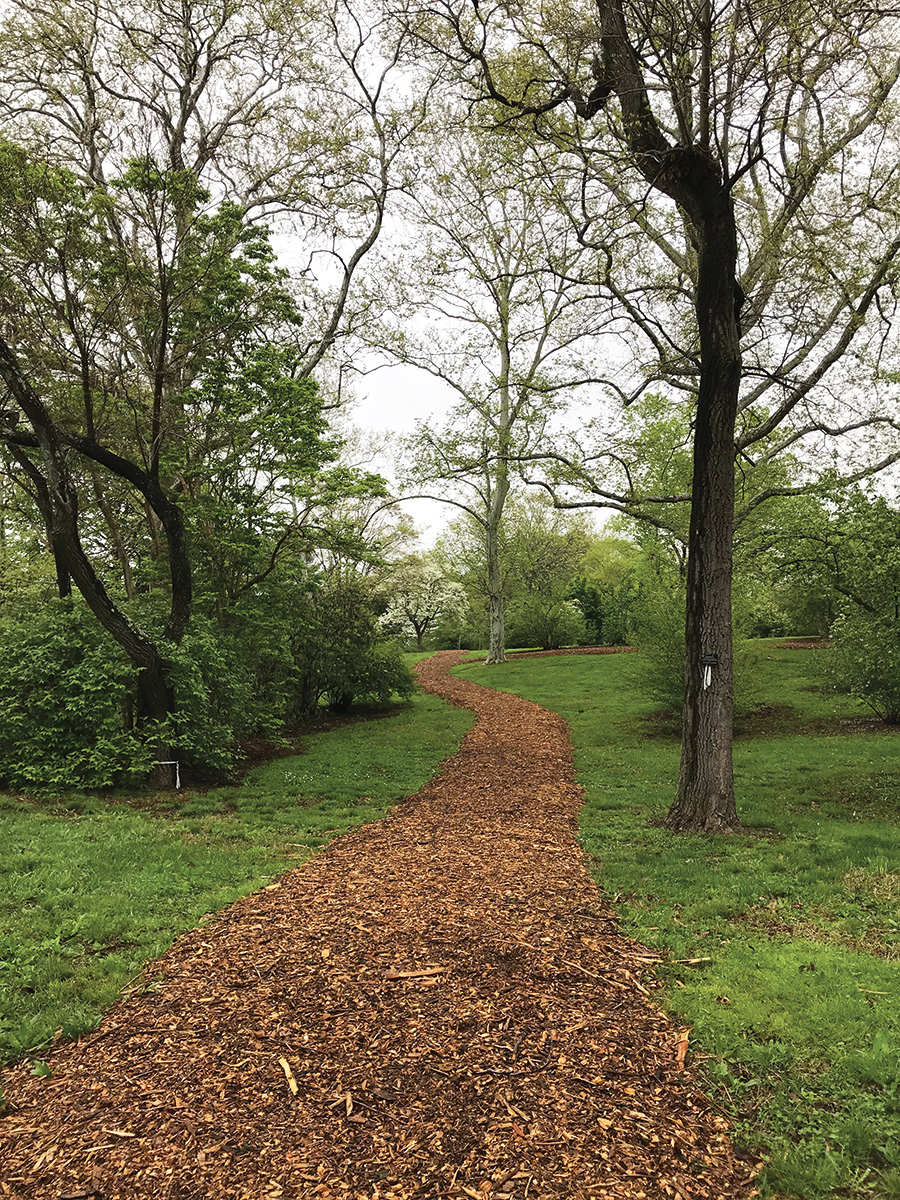Two roads diverged in a yellow wood: Frost’s words come to mind unbidden as I walk through the Arnold amid November’s yellowing days, following forking paths that might take me to the Hunnewell Building and the workday, to Weld Hill for a lecture, or into the conifers for a quiet afternoon copyediting in the company of wild turkeys. It’s worth remembering that intersections are also convergences, comings-together for travelers from different points of origin. The arboretum itself is such an intersection, where two grand ways of working with plants, the scientific and the horticultural, converge. How many other ways of knowing, feeling, and storying trees also meet at this crossroads?
Some convergences come after long travel. Turning off Meadow Road, I approach the golden glow of the katsuras—though even before I arrive, they’ve already announced themselves by their characteristic caramel fragrance. One of these specimens of Cercidiphyllum japonicum, 882*A, is among the oldest trees in the arboretum, accessioned in 1878. But katsura’s path is far older: fossil evidence shows them thriving in forests of the northern hemisphere by the end of the Cretaceous, some seventy million years ago. We say that katsura smells like cotton candy—the German name for the tree is Kuchenbaum, or “cake tree”—but isn’t it properly the other way round? Cakes and cotton candy, those latecomers, smell like katsura, whose fragrance of toasted sugar, tens of millions of years in the making, likely wafted long before there were noses attached to humans with a propensity for naming, propagating, and choosing tree-convergent ways.
So these converging paths through trees are generous, gregarious, inspiring. Richard Powers begins his 2018 novel The Overstory with a powerful invocation of trees as generous storytellers:
A woman sits on the ground, leaning against a pine. Its bark presses hard against her back, as hard as life. Its needles scent the air and a force hums in the heart of the wood. Her ears tune down to the lowest frequencies. The tree is saying things, in words before words.
It says: Sun and water are questions endlessly worth answering.
It says: A good answer must be reinvented many times, from scratch.
It says: Every piece of earth needs a new way to grip it. There are more ways to branch than any cedar pencil will ever find. A thing can travel everywhere, just by holding still.
The woman does exactly that. Signals rain down around her like seeds.
With this year’s Spring issue, Arnoldia debuted a new design and editorial format; in the very same moment, I joined as editor. I can take no credit for this new vision for the magazine, which was brought forward by Michael Dosmann, and my predecessor, Jonathan Damery, in collaboration with members of Arnoldia’s editorial committee and our consulting design studio, Point Five. I’ve been thrilled by all the new ways they have furnished me to know, story, and connect with trees—not only through a profusion of new literary forms, including poetry and creative nonfiction, but drawing from the visual arts as well. We’ve welcomed verse from emerging and prizewinning poets, and book excerpts from provocative scholarly works like Rosetta Elkin’s Plant Life (Fall), to Cold Canyon Fire Journals by Robin Lee Carlson, whose distinctive, lyrical art and storytelling about wildfire and place in California enriches this issue (page 16). Our editorial artist, Matt Huynh, provides each issue’s Notes from the Field section with a fresh set of expressive illustrations, while our endpapers by Shyama Golden frame the magazine with sumptuous assemblages drawn from the shifting seasons. At the same time, this renewed Arnoldia also brings forth the scholarly and scientific research that have long been the magazine’s mainstay, such as Peter Del Tredici’s article in this issue on the fascinating phenomenon of endocormic roots (page 30). And most crucially, we’re making space for authors whose voices historically have not been heard along the paths of science and the garden. Native voices, the voices of folks of color, the unhoused—Arnoldia seeks to come into restorative relation with such authors, and to bring the knowledge they carry to our readers.
These converging paths through trees are generous, gregarious, inspiring.
Arnoldia’s rebirth comes at a time of both richness and urgency, with an efflorescence of innovative writing about the natural world arriving from new directions, prompted by climate change, calls for environmental justice, and the enormity of the biodiversity crisis. And so now is a crucial time to bring forth this expanded editorial mission and toolkit for telling tree-entangled stories.
Meanwhile, the Arnold’s paths proliferate. The horticulture team has been laying new trails throughout the landscape, giving visitors more immediate access to our collections. And in the years to come, the Roslindale Gateway Path Project will connect Forest Hills to Roslindale Center, making even more of this living landscape into an equitable contact zone. As these paths intersect, new stories surely will emerge.
Our former tagline was The Magazine of the Arnold Arboretum; now, it’s The Nature of Trees. An intersection for more than science and horticulture, this nature is a gregarious convergence of lyric, memoir, storytelling, and scholarship. Who speaks to the nature of trees? Everyone. May Arnoldia continue to be as generous as the katsura, as message-bringing as Powers’ fragrant pine. May it be a crossroads, a meeting place. And may it always be thronged with trees.
Matthew Battles is the editor of Arnoldia.
